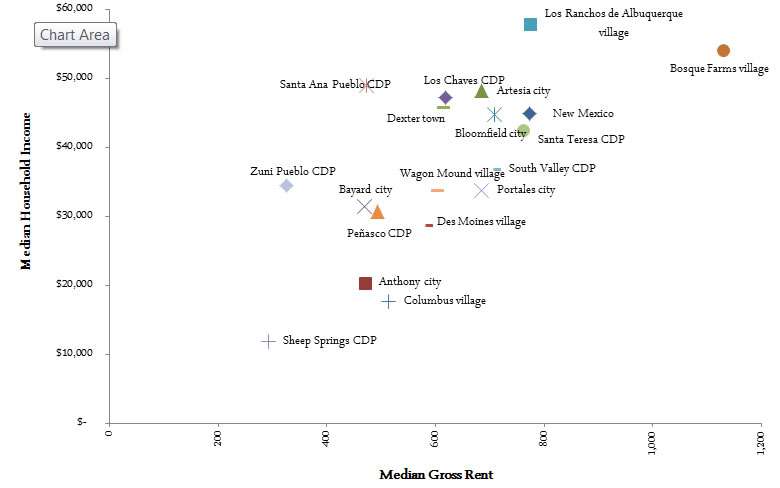US Census Bureau releases statistics of five-year estimates from American Community Survey

The U.S. Census Bureau released today American Community Survey's five-year estimates for 2014. These data cover information for small area populations and are important in analyzing neighborhood characteristics. The American Community Survey is an ongoing survey that provides detailed information on a yearly basis.
This information was released locally by the University of New Mexico's Bureau of Business and is important for public officials, planners and business in assessing the needs for services of various population groups.
For 10 years, the American Community Survey has provided U.S. communities with detailed information critical for making informed decisions about their people, places and economy. Today, the U.S. Census Bureau released the latest American Community Survey five-year statistics, allowing users for the first time to compare two non-overlapping five-year data sets: 2005-2009 and 2010-2014. Users can now identify trends for social and economic characteristics for even the smallest communities on a more frequent basis. As a result, housing and population statistics are available as of 2014 down to the tract level. The following chart depicts Median Household Income versus the Median Gross Rent for selected small communities across New Mexico.
Selected ACS 5-year 2014 statistics for New Mexico:
- The 2014 state population was 2,080,085.
- In New Mexico 26.1 percent of the population 25-Years and older had earned a bachelor's degree or higher.
- The Median Household Income statewide was $44,968.
- The Median housing costs for households with a mortgage was $1,242.
- The homeowner occupancy rate among households in the state was 68 percent.
- Statewide 21 percent of the population was in poverty, 25.8 percent for the Hispanic population, and 35.3 percent for American Indian and Alaska Natives.
Prior to the American Community Survey, these detailed characteristics were only available once a decade from the census. To meet the demand for more current statistics for national and local decision-making, the Census Bureau responded by developing a survey that would provide more timely data. In 2010 the American Community Survey replaced the Decennial Census long form, which was previously used. Approval by Congress helped turn the Census Bureau's innovation into the American Community Survey.

As the nation's largest ongoing household survey, the American Community Survey produces statistics annually at all levels of geography, down to the block group level for every community in the nation and Puerto Rico.
In addition to today's release of statistics using data collected between 2010 and 2014, the Census Bureau has produced a series of maps; detailing county-level change for six socio-economic characteristics. Without the American Community Survey, these maps would only be possible every 10 years. The maps highlight just a few of the more than 40 topics available from the American Community Survey that public officials, community leaders, business owners, researchers and many others rely on to plan and make decisions.
Topics included are:
- Housing (Computer Ownership & Internet Access, House Heating Fuel, Rent Statistics, Value of Home)
- Economic (Commuting to Work/Journey to Work, Industry and Occupation, Health Insurance, Poverty, Work Status)
- Social (Ancestry, Citizenship Status, Disability Status, Educational Attainment, Place of Birth, School Enrollment, Residence 1 Year Ago/Migration, Veterans)
Furthermore to the statistics released today, the 2014 Small Area Income and Poverty Estimates will be released next week. These estimates provide single-year income and poverty statistics for all counties and school districts nationally. Data from the American Community Survey are an important input to these estimates.
Also released today from the American Community Survey:
- Census Business Builder: Small Business Edition, a Web tool that allows business owners and entrepreneurs to easily navigate and use key demographic and economic data, has been updated with the new 2010-2014 American Community Survey statistics.
- Application programming interface updated with 2010-2014 American Community Survey data.
- Narrative profiles are available for state, county, place, metropolitan/micropolitan statistical area, ZIP code tabulation area, American Indian Area/Alaska Native area/Hawaiian Home Land and census tract. Narrative profiles summarize many topics using nontechnical text and graphs.
- Statistics from the Puerto Rico Community Survey are available for geographic levels down to the block group level.
When to use 1-year or 5-year estimates
Choosing which dataset involves more than simply considering the population size in your area. You must think about the balance between currency and sample size/reliability/precision. Whereas 1-year estimates cover geographies with populations of 65,000+, the one-year estimates cover the 12 month period from Jan. 1, 2014 thru Dec. 31, 2014 while the five-year estimates encompass the 60 month period from Jan. 1, 2010 and Dec. 31, 2014. Given the release of one-year estimates earlier in the calendar year, these statistics are more current; however, the five-year estimates are more accurate given the broader sampling. The three-year estimates have been discontinued by the U.S. Census due to the lack of funding.
Because the statistics are from a survey based on a sample of the population rather than the entire population, the American Community Survey produces estimates. To aid data users, the Census Bureau calculates and publishes a margin of error for every estimate. The guidance on making comparisons, visit U.S. Census Bureau.
Provided by University of New Mexico


















